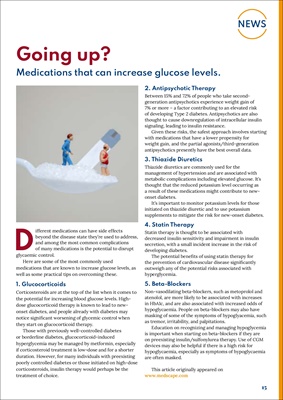
15
NEWS
Going up?
Medications that can increase glucose levels.
Different medications can have side effects
beyond the disease state they're used to address,
and among the most common complications
of many medications is the potential to disrupt
glycaemic control.
Here are some of the most commonly used
medications that are known to increase glucose levels, as
well as some practical tips on overcoming these.
1. Glucocorticoids
Corticosteroids are at the top of the list when it comes to
the potential for increasing blood glucose levels. Highdose glucocorticoid
therapy is known to lead to newonset
diabetes, and people already with diabetes may
notice significant worsening of glycemic control when
they start on glucocorticoid therapy.
Those with previously well-controlled diabetes
or borderline diabetes, glucocorticoid-induced
hyperglycemia may be managed by metformin, especially
if corticosteroid treatment is low-dose and for a shorter
duration. However, for many individuals with preexisting
poorly controlled diabetes or those initiated on high-dose
corticosteroids, insulin therapy would perhaps be the
treatment of choice.
2. Antipsychotic Therapy
Between 15% and 72% of people who take secondgeneration
antipsychotics experience weight gain of
7% or more - a factor contributing to an elevated risk
of developing Type 2 diabetes. Antipsychotics are also
thought to cause downregulation of intracellular insulin
signaling, leading to insulin resistance.
Given these risks, the safest approach involves starting
with medications that have a lower propensity for
weight gain, and the partial agonists/third-generation
antipsychotics presently have the best overall data.
3. Thiazide Diuretics
Thiazide diuretics are commonly used for the
management of hypertension and are associated with
metabolic complications including elevated glucose. It's
thought that the reduced potassium level occurring as
a result of these medications might contribute to newonset
diabetes.
It's important to monitor potassium levels for those
initiated on thiazide diuretic and to use potassium
supplements to mitigate the risk for new-onset diabetes.
4. Statin Therapy
Statin therapy is thought to be associated with
decreased insulin sensitivity and impairment in insulin
secretion, with a small incident increase in the risk of
developing diabetes.
The potential benefits of using statin therapy for
the prevention of cardiovascular disease significantly
outweigh any of the potential risks associated with
hyperglycemia.
5. Beta-Blockers
Non-vasodilating beta-blockers, such as metoprolol and
atenolol, are more likely to be associated with increases
in HbA1c, and are also associated with increased odds of
hypoglycaemia. People on beta-blockers may also have
masking of some of the symptoms of hypoglyacemia, such
as tremor, irritability, and palpitations.
Education on recognizing and managing hypoglycemia
is important when starting on beta-blockers if they are
on preexisting insulin/sulfonylurea therapy. Use of CGM
devices may also be helpful if there is a high risk for
hypoglycaemia, especially as symptoms of hypoglycaemia
are often masked.
This article originally appeared on
www.medscape.com